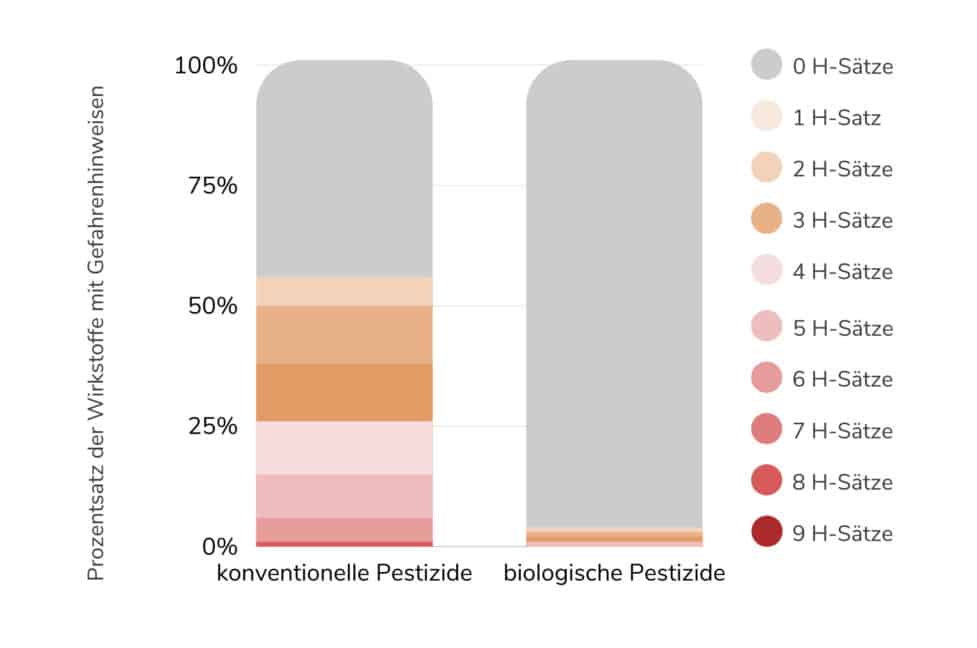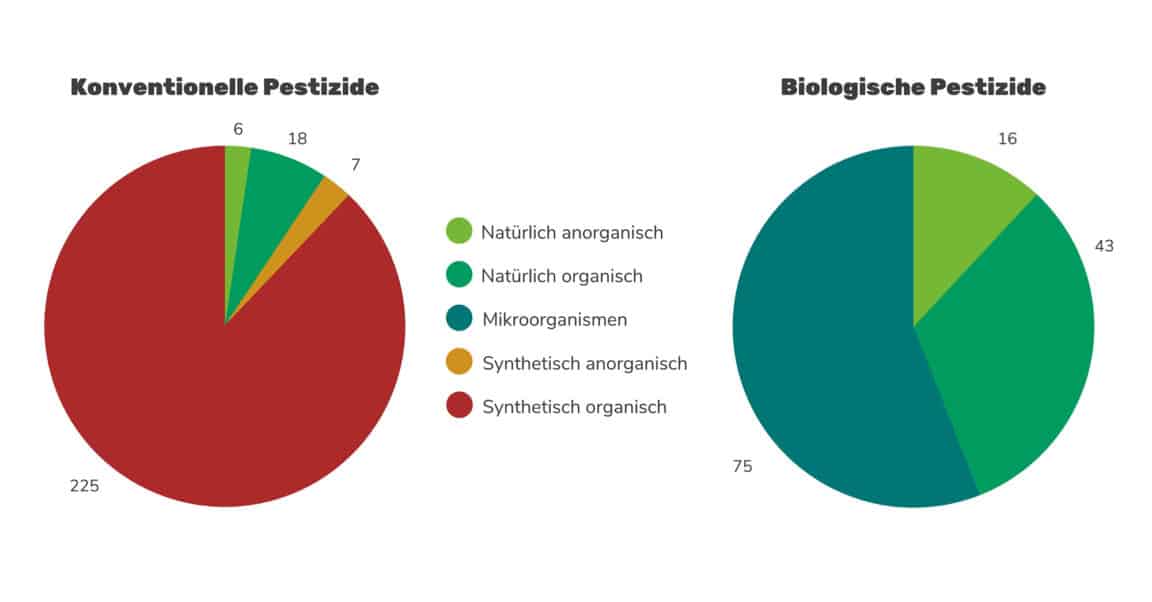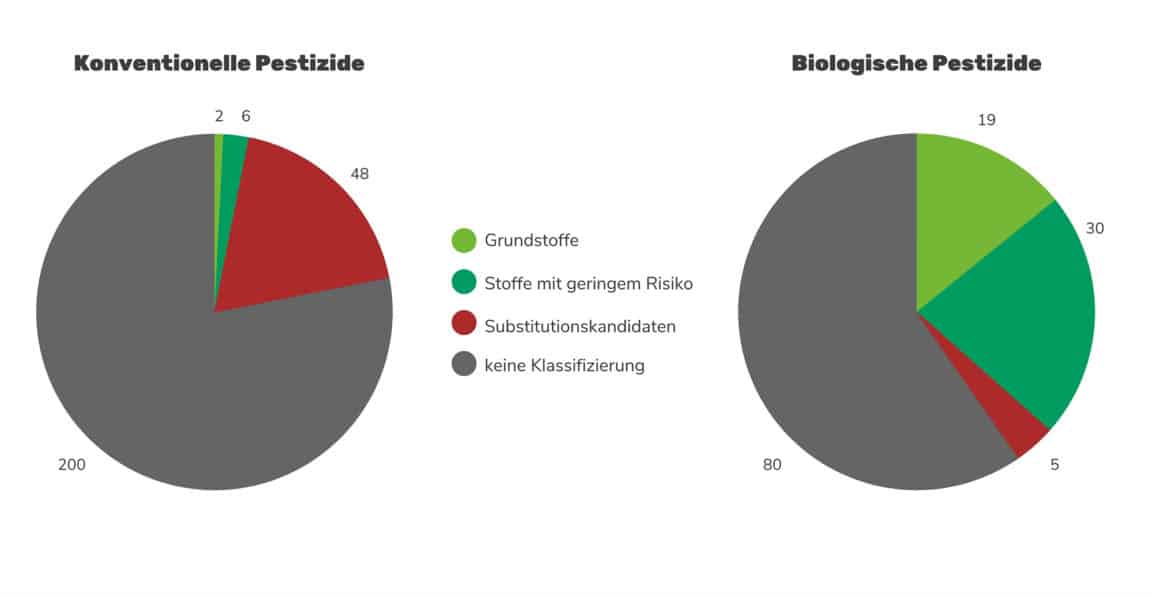The European Green Deal targets to increase organic farming to 2030% across the EU by 25, the use and risk of pesticides and to protect sensitive areas from the negative effects of pesticides are making the natural pesticides permitted in organic farming a subject of increasing political interest. But while some see promising alternatives to the use of chemically synthesized pesticides in natural pesticides, pesticide manufacturers such as Bayer, Syngenta and Corteva warn public against “environmental trade-offs associated with an increase in organic farming” such as the “increase in the overall volume of pesticide use in Europe.”

On behalf of IFOAM Organics Europe, the European umbrella organization for organic farming, GLOBAL 2000 subjected this alleged conflict of goals to a one-off facts check. In it, the differences between the 256 pesticides used in conventional agriculture and the 134 pesticides that are also permitted in organic agriculture are analyzed with regard to their potential dangers and risks as well as the frequency of their use. The underlying toxicological assessment was subsequently published in the scientific journal "Toxics". published. The hazard classifications of the Globally Harmonized System (GHS) specified by the European Chemicals Agency (EChA) and the nutritional and occupational health reference values specified by the European Food Safety Authority (EFSA) in the approval process served as a benchmark for the comparison.
Difference organic versus conventional highly significant
Of the 256 mostly synthetic active ingredients in pesticides that are only permitted in conventional agriculture, 55% bear indications of health or environmental hazards; of the 134 natural active ingredients that are (also) permitted in organic farming, it is only 3%. Warnings about possible harm to the unborn child, suspected carcinogenicity or acute lethal effects were found in 16% of the pesticides used in conventional agriculture, but in no pesticide with organic approval. The EFSA considered the determination of nutritional and occupational health reference values to be appropriate for 93% of the conventional active ingredients but only 7% of the natural ones.

"The differences that we found are as significant as they are unsurprising when you take a closer look at the origin of the respective pesticide active ingredients," he said Helmut Burtscher-Schaden, biochemist from GLOBAL 2000 and first author of the study: "While around 90% of conventional pesticides are chemical-synthetic in origin and have undergone screening programs to identify the substances with the highest toxicity (and thus highest effectiveness) against the target organisms, the majority of natural active ingredients are not at all actually about substances, but about living microorganisms. These account for 56% of approved 'bio-pesticides'. As natural soil dwellers, they have no dangerous material properties. A further 19% of bio-pesticides are classified a priori as “low-risk active ingredients” (e.g. baking soda) or authorized as raw materials (e.g. sunflower oil, vinegar, milk).”

Alternatives to pesticides
Jan Plagge, President of IFOAM Organics Europe comments as follows: "It is clear that the synthetic active ingredients permitted in conventional agriculture are far more dangerous and problematic than the natural active ingredients permitted in organic farming. Organic farms focus on preventative measures such as using robust varieties, sensible crop rotations, maintaining soil health and increasing biodiversity in the field to avoid using external inputs. For this reason, no pesticides are used on around 90% of agricultural land (especially in arable farming), nor are any natural substances. Should the pests nevertheless get the upper hand, the use of beneficial insects, microorganisms, pheromones or deterrents is the second choice of organic farmers. Natural pesticides such as the minerals copper or sulphur, baking powder or vegetable oils are the last resort for special crops such as fruit and wine.”
Jennifer Lewis, Director of the Federation of Biological Crop Protection Manufacturers (IBMA) refers to the "enormous potential" of the natural pesticides and methods already available today for conventional and organic farmers. “We need to speed up the approval process for biological pest control so that these products are available to all farmers in Europe. This will support the transition to a more sustainable, biodiversity-friendly food system as outlined in the European Green Deal.”
Lili Balogh, President of Agroecology Europe and farmer emphasizes: “The implementation of the Farm to Fork strategy and the biodiversity strategy with their pesticide reduction targets is essential to establish resilient, agroecological food systems in Europe. The aim of agriculture should always be to promote biodiversity and the associated ecosystem services as far as possible, so that the use of external inputs becomes obsolete. With preventive and natural plant protection measures, such as a diversity of species and varieties, smallholder structures and the avoidance of synthetic pesticides, we are creating a sustainable agricultural and food system that survives crises well.”
Links/Downloads:
- Recording of the press conference (Youtube)
- Scientific study to compare conventional and organic pesticides
- Petition “Poison for the bee. Poison for you."
Photo / Video: Global 2000.



